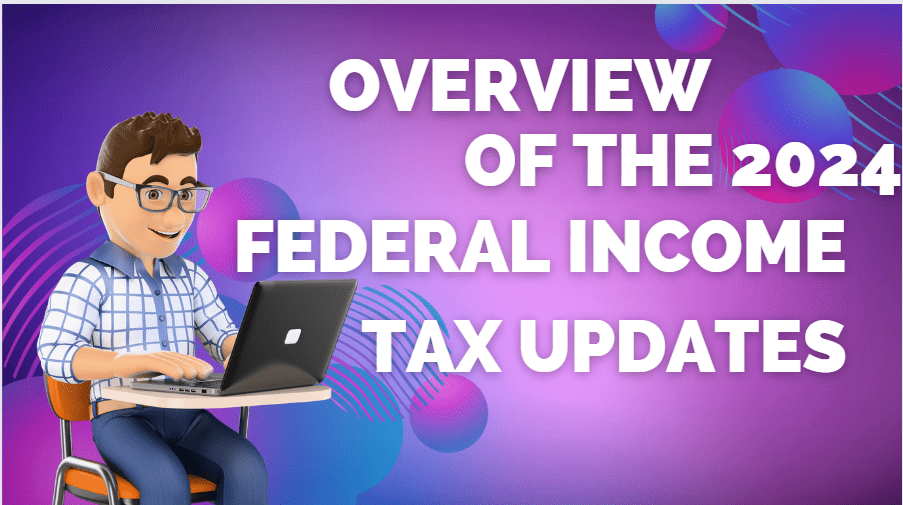Introduction
The federal income tax system in the United States is a crucial aspect of the nation’s economy, affecting individuals and businesses alike. Each year, the Internal Revenue Service (IRS) updates tax regulations, thresholds, and policies to reflect economic changes, legislative adjustments, and other influencing factors. The 2024 update brings several significant changes that taxpayers must be aware of. This comprehensive article delves into the latest federal income tax data, outlining the key updates for 2024, providing detailed insights into their implications, and offering guidance on navigating the new tax landscape effectively.

Overview of the 2024 Federal Income Tax Updates
1. Adjusted Tax Brackets for Inflation
One of the most anticipated changes each year is the adjustment of tax brackets for inflation. For 2024, the IRS has made the following adjustments:
- 10% Bracket: Up to $11,000 for single filers (up from $10,725) and $22,000 for married couples filing jointly (up from $21,450).
- 12% Bracket: $11,001 to $44,725 for single filers (up from $43,850) and $22,001 to $89,450 for married couples filing jointly (up from $87,700).
- 22% Bracket: $44,726 to $95,375 for single filers (up from $94,050) and $89,451 to $190,750 for married couples filing jointly (up from $188,100).
- 24% Bracket: $95,376 to $182,100 for single filers (up from $182,000) and $190,751 to $364,200 for married couples filing jointly (up from $364,200).
- 32% Bracket: $182,101 to $231,250 for single filers (up from $231,250) and $364,201 to $462,500 for married couples filing jointly (up from $462,500).
- 35% Bracket: $231,251 to $578,125 for single filers (up from $578,100) and $462,501 to $693,750 for married couples filing jointly (up from $693,750).
- 37% Bracket: Over $578,125 for single filers (up from $578,100) and over $693,750 for married couples filing jointly (up from $693,750).
2. Standard Deduction Increases
The standard deduction has also been adjusted for inflation, providing taxpayers with a higher threshold before itemized deductions become advantageous. The 2024 standard deductions are as follows:
- Single Filers: $14,400 (up from $13,850).
- Married Couples Filing Jointly: $28,800 (up from $27,700).
- Heads of Household: $21,200 (up from $20,800).
3. Changes to Itemized Deductions
For those who itemize their deductions, the IRS has made several changes:
- Medical and Dental Expenses: The threshold for deductible medical and dental expenses remains at 7.5% of adjusted gross income (AGI).
- State and Local Taxes (SALT): The cap on SALT deductions remains at $10,000.
- Mortgage Interest Deduction: No significant changes, continuing the limit on mortgage debt up to $750,000 for loans taken out after December 15, 2017.
- Charitable Contributions: The limit for cash contributions to public charities remains at 60% of AGI.
4. Updates to Tax Credits
Tax credits can significantly reduce a taxpayer’s liability. The key updates for 2024 include:
- Child Tax Credit: The credit remains at $2,000 per qualifying child, with the refundable portion capped at $1,600.
- Earned Income Tax Credit (EITC): The maximum credit amounts for 2024 are:
- $7,680 for taxpayers with three or more qualifying children.
- $6,680 for taxpayers with two qualifying children.
- $4,270 for taxpayers with one qualifying child.
- $600 for taxpayers with no qualifying children.
- Education Credits: The American Opportunity Tax Credit (AOTC) remains at a maximum of $2,500 per student, and the Lifetime Learning Credit (LLC) remains at $2,000 per return.
5. Retirement Contribution Limits
Contribution limits for retirement accounts have increased for 2024:
- 401(k), 403(b), and most 457 plans: The limit has increased to $23,000 (up from $22,500).
- Catch-up contributions for those aged 50 and over: An additional $7,500 (up from $7,500).
- IRA Contributions: The limit has increased to $7,000 (up from $6,500), with an additional $1,500 catch-up contribution for those aged 50 and over.
6. Health Savings Account (HSA) Limits
HSA contribution limits have been adjusted for inflation:
- Self-only coverage: The limit is now $4,150 (up from $3,850).
- Family coverage: The limit is now $8,300 (up from $7,750).
- Catch-up contributions for those aged 55 and over: An additional $1,000.
7. Estate and Gift Tax Exclusions
The estate and gift tax exclusion amounts have been increased:
- Estate Tax Exclusion: $12.92 million per individual (up from $12.06 million).
- Gift Tax Exclusion: $17,000 per recipient (up from $16,000).
8. Corporate Tax Rates
Corporate tax rates remain at a flat 21%, following the changes implemented by the Tax Cuts and Jobs Act of 2017. However, there are adjustments in the treatment of certain deductions and credits that corporations can claim.
Detailed Analysis of the 2024 Updates
1. Impact of Inflation Adjustments on Taxpayers
Inflation adjustments to tax brackets and deductions help mitigate the impact of inflation on taxpayers’ liabilities. These adjustments ensure that taxpayers do not pay higher taxes solely due to inflation-driven income increases. For 2024, the changes are particularly significant due to the higher-than-usual inflation rates experienced in 2023.
2. Strategic Use of Standard vs. Itemized Deductions
Taxpayers must evaluate whether to take the standard deduction or itemize their deductions. The increased standard deduction for 2024 means that more taxpayers will likely benefit from taking the standard deduction rather than itemizing. However, those with significant medical expenses, mortgage interest, or charitable contributions may still find itemizing beneficial.
3. Maximizing Tax Credits
Understanding the available tax credits is essential for reducing tax liability. The Child Tax Credit and Earned Income Tax Credit, in particular, offer substantial benefits. Taxpayers should ensure they meet the eligibility requirements and claim the maximum credit available.
4. Retirement Planning and Tax Benefits
Contributing to retirement accounts not only helps secure a financial future but also offers tax benefits. The increased contribution limits for 401(k) plans and IRAs for 2024 provide an opportunity for taxpayers to save more while reducing their taxable income.
5. Health Savings Accounts
HSAs offer a triple tax advantage: contributions are tax-deductible, earnings grow tax-free, and withdrawals for qualified medical expenses are tax-free. The increased contribution limits for 2024 make HSAs an even more attractive option for those with high-deductible health plans.
6. Estate and Gift Tax Planning
The increased estate and gift tax exclusions for 2024 provide an opportunity for wealth transfer planning. Individuals can transfer more wealth without incurring federal estate or gift taxes, making it essential to review and potentially update estate plans.
7. Corporate Tax Considerations
While the corporate tax rate remains unchanged, businesses should be aware of changes in deductions and credits that could impact their tax liability. Staying informed about these changes is crucial for effective tax planning and compliance.
Navigating the 2024 Tax Season: Practical Tips
1. Early Preparation
Start gathering tax documents and information early. Early preparation can help identify potential deductions and credits and ensure timely and accurate filing.
2. Consult a Tax Professional
Tax laws and regulations can be complex. Consulting with a tax professional can help navigate the changes, optimize tax strategies, and ensure compliance.
3. Utilize Tax Software
Tax software can help simplify the tax filing process. Many programs are updated to reflect the latest tax changes and can help ensure accuracy and maximize refunds.
4. Keep Updated with IRS Announcements
The IRS frequently issues updates and guidance on tax regulations. Staying informed about these announcements can help ensure compliance and take advantage of new benefits.
5. Review and Adjust Withholding
Review and adjust withholding to ensure the correct amount of tax is withheld from paychecks. This can help avoid surprises at tax time and ensure a smooth filing process.
Conclusion
The 2024 federal income tax updates bring several significant changes that taxpayers must be aware of. From adjusted tax brackets and increased standard deductions to changes in tax credits and retirement contribution limits, understanding these updates is crucial for effective tax planning and compliance. By staying informed and taking proactive steps, taxpayers can navigate the new tax landscape effectively and optimize their tax outcomes.
